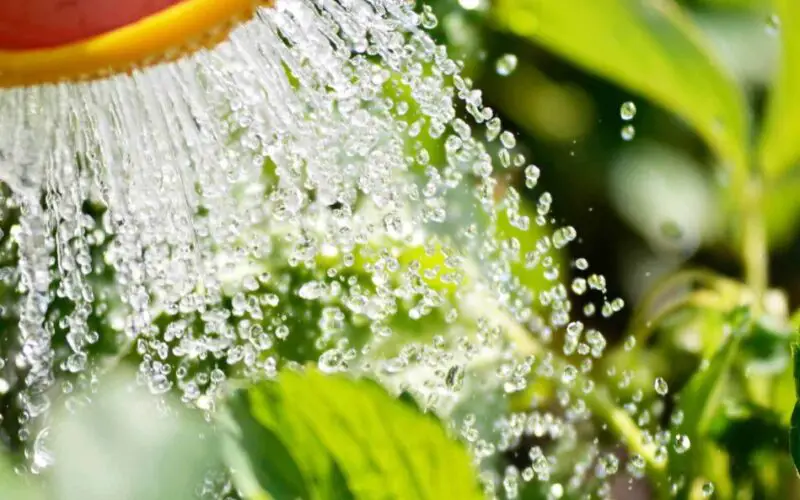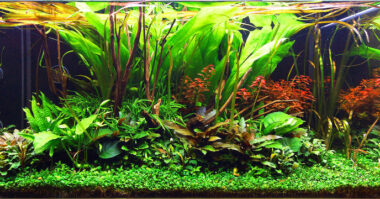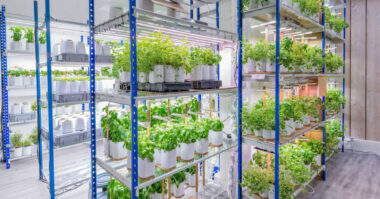A plant is on average 85% water. Water has very important roles in the plant. It allows the transport of essential elements. Water enters through the roots where it carries all the elements the plant needs to feed itself: phosphorus, potassium, but especially nitrogen.
Water also participates in the process of photosynthesis. The plant sucks a gas from the air through its leaves: carbon dioxide. It then combines this gas with water thanks to the energy of the sun. All this is then transformed into sugars, called “carbohydrates”. This is called “photosynthesis”.
Contents
How plant watering works
Plants use a lot of water, up to several tens or even hundreds of liters per day in a large tree like the oak for example.
First, water is essential for the plant to capture carbon dioxide (CO2) to transform it into oxygen that we breathe: this is called photosynthesis. Secondly, this water transports dissolved mineral elements (nitrogen, phosphorus, potassium, absorbed from the soil) essential for the proper functioning of the leaf.
However, this water represents only an almost negligible part of all that absorbed by the plant. More than 98% of the water evaporates from the leaves to cool down the temperature of the plant: this is called transpiration. The main role of transpiration is to regulate the temperature to prevent the plant from burning out (like sweat regulates body heat in humans). Thus, almost all of the water drawn from the soil simply passes through the plant before evaporating into the atmosphere.
The question is all the more relevant as we ourselves can be victims of dehydration without knowing it… Moreover, is water the same when it is blood or sap, interstitial, cellular, rain, river, cloud, urine or saliva? If heat, water, light and matter are the udders of cellular development, only H2O allows to reveal the genetic potential of a plant.
Should I water my garden?
Knowing that the cell of a pluricellular being must be constantly bathed in water in order to live, and that the absence of water is the primary cause of famines, it is not superfluous to dwell on this question, because two schools of thought are making the rain and the sun shine on this field.
One school systematically waters drop after drop or by cannons and sprinklers, and the other does not water and advocates the total absence of irrigation under the pretext that the humus of its soils, coupled with wood and mulch, allows for the conservation of moisture in the long term. It should be noted that in chemical agriculture, we even cultivate varieties selected to be irrigated…
Apart from these two radical positions, one question remains: How do you know if a plant is thirsty?
By asking it, I would answer… But for those who don’t speak their language, observation and attention remain 2 excellent means to evaluate their needs.
How to water according to the plants?
Plants in pots
They are prisoners of the volume they have been given. For them, there is no question of getting water elsewhere, unless the roots escape through the drainage hole (the holes at the bottom of the pot), which is not desirable for many reasons. Therefore, potted plants should be watered regularly. Often, the novice gardener wonders how often to water.
The answer is not complicated: there is no right frequency, just water when the plant is thirsty! If it has rained, is cool or the plant has a large volume of soil in its pot, there is no need to rush to the watering can. If, on the other hand, the weather is hot or windy, you should check the soil regularly. If the surface of the soil is dry to the touch, you may need to moisten it a little.
Young plants
A seedling, which has a small volume root ball at planting, has few possibilities to get water from the surroundings. Very quickly, it will emit roots to explore the surroundings (if the ground was well worked). But at the beginning, it is in the ground as in a pot and watering helps it to maintain itself while waiting for the roots to become one with the ground. Even plants that don’t need watering as adults need this help, in the first year for example.
How to water your garden and plants?
It is recommended to water your garden less often, but more intensively. You can also recover rainwater to save money, but also a good gesture for the planet. In addition to the traditional watering can, you can opt for the drip system or a sprinkler. The hose can also be used, but be careful not to use it too hard. This could harm your plants.
How to optimize the water supply to the plants?
It is interesting to set up a good mulch which will allow to cover the ground so as to limit the phenomenon of evaporation during the day, while preserving a good humidity at the level of the ground which will also allow you to space out your waterings more easily. The last point I would like to address here is the spacing between your watering …
It is better to water your plants more abundantly and less regularly than to water them every day in small quantities. This will “force” the plants to go and find the water reserves in depth, also getting them used to it and consequently, you will be able to go away for a few days without having to worry about watering your vegetable garden.
Summary
Water is an essential element for the life of plants. Optimizing the water supply in the garden has several objectives: to satisfy the needs of the plants, to avoid imbalances (too much or too little) favorable to the development of diseases and parasites, and finally to avoid waste.
Observing the soil and the plants, preferably in the morning, to better understand the relationship between water, soil and plant, allows you to better manage the watering of your garden.
Each plant species is more or less greedy for water, more or less sensitive to lack or excess of watering. The requirements of each species are described on the labels, in guides and catalogs.
Winter generally corresponds to the vegetative rest of the plants; in the garden, rain is often sufficient, even excessive. On the other hand, in spring and summer, the important evapotranspiration of the soil and the plants, as well as the absence of rain must be compensated by watering.
The needs also vary according to the stage of vegetation. The needs are thus more important during the sowing, planting, repotting and during the growth phases.









